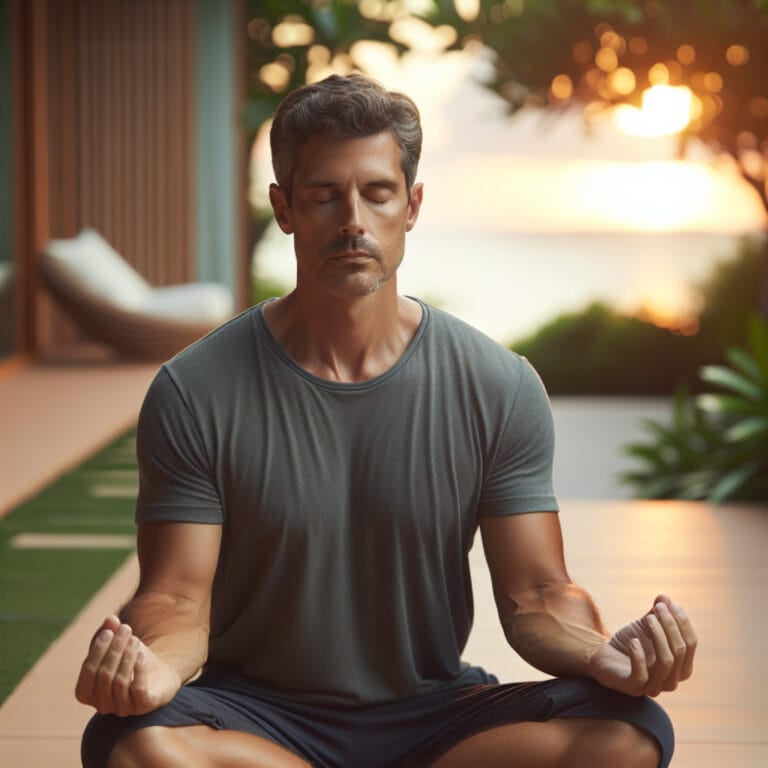
Experience Migraine Relief with Yogic Breathing Techniques
Table of Contents
- Introduction
- Understanding Migraines
- The Science of Yogic Breathing
- Yogic Breathing Techniques for Migraine Relief
- The Benefits of Yogic Breathing for Migraine Sufferers
- Conclusion
- Frequently Asked Questions
Introduction
Recent research shows a promising link between yogic breathing techniques and effective migraine management. With over a billion people suffering from migraines worldwide, this natural, non-pharmacological approach can provide much-needed relief. Yoga poses and paced breathing exercises not only help to reduce stress but also balance the nervous system. Dr Buse from the American Migraine Foundation suggests that such deep breathing practices can calm the sympathetic nervous system, thus reducing tension and potentially preventing painful migraines.
Yogrishi Vishvketu, an internationally renowned yoga master, emphasizes on simple yet profound breathing techniques like Bhramari Pranayama in one’s personal yoga practice for migraine relief. This simple technique involves sitting in a comfortable position with eyes closed, inhaling deeply through your nose and exhaling slowly while making a humming sound. The vibrations created by this process are known to soothe the mind and alleviate headache symptoms.
By incorporating these easy-to-perform exercises into their daily routine, chronic migraine sufferers have found significant improvement in their condition. Moreover, as per another study led by Migraine Relief Center; practicing yogic breath control exercises has shown to reverse even chronic cases of migraines over time.
Interestingly enough is how beneficial these practices are for overall health as well; it’s not just about relieving headaches or preventing future ones but truly leading a more relaxed life overall – balancing Vata dosha grounding -, improving sleep quality, enhancing mood stability among other meditation benefits techniques that form an integral part of yoga.
To sum up: Integrating these powerful paced-breathing practices into your everyday life may offer reliable aid against frequent migraine attacks & its results- providing instant relief as well as long-term healing benefits. It’s definitely worth exploring how you could incorporate these effective breathing exercises into your routine for better migraine management.
Understanding Migraines
Migraines, a neurological condition typically characterized by intense, debilitating headaches, affect over a billion people globally; making it not just an individual health concern but also a widespread public health issue. The throbbing or pulsating pain usually begins in the forehead, temple or back of the eye and can progress to severe discomfort often accompanied by sensitivity to light and sound, nausea and vomiting. These migraine symptoms can last for hours and in extreme cases even days, disrupting daily activities significantly.
Studies reveal that migraines are triggered when stress activates the sympathetic nervous system – which controls our fight or flight response – leading to reduced blood flow in the brain. This is where yogic breathing exercises come into play; they help reduce tension by activating the parasympathetic nervous system responsible for rest and relaxation. Paced breathing practices like Bhramari Pranayama emphasize slow, deep inhalation followed by long sustained exhalation while seated comfortably; this technique could potentially deactivate these triggers thereby providing significant headache relief.
This theory was supported through extensive migraine relief research led by Dr Buse from American Migraine Foundation who stated that such mindful practices encourage relaxation thus easing stress-linked muscle tension known to ignite migraines. Attesting this statement is Yogrishi Vishvketu who introduced simple yet impactful deep breathing exercises like ‘min practice’ into his personal yoga routine with positive results – citing yoga poses as an effective non-pharmacological approach against migraines.
Moreover, additional benefits include balancing Vata dosha grounding – believed in Ayurveda to promote stability and calmness -, improving sleep quality & overall mood stability using meditation techniques part of common yoga practices. Chronic migraine sufferers who incorporated these exercises noted substantial improvement overtime even reversing their condition as per studies conducted at Migraine Relief Center.
To put it simply: Despite being intensely painful and hugely prevalent worldwide – migraines remain widely misunderstood & underdiagnosed leaving sufferers desperate for reliable and accessible solutions. Incorporating these simple breathing techniques into a daily routine isn’t merely about immediate headache relief but also fostering an overall relaxed life – providing both instant relief and long-term healing benefits for effective migraine management. The promise that yogic breathing holds in the realm of migraine relief is indeed profound; it not only provides hope for the billion people suffering from migraines worldwide but paves way to a holistically healthier lifestyle through stress management.
The Science of Yogic Breathing
A staggering number of over a billion people suffering from migraines worldwide find solace in the ancient wisdom of yoga. Recent migraine relief research shows that simple yet profound yogic breathing techniques, such as Bhramari Pranayama and paced breathing exercises, can significantly alleviate painful symptoms and reduce the frequency of migraine attacks. Let’s delve into the science behind these practices.
Yogic breathing, also known as Pranayama, is more than just taking deep breaths—it is an artful discipline involving controlled inhalation, retention, and exhalation. Among various exercises available, paced breathing and Bhramari Pranayama are particularly notable for their potential to provide headache relief – min practice required making it accessible for anyone at any time. Paced breathing involves slow inhalation followed by a longer exhale while seated comfortably; this rhythm calms our nervous system and induces relaxation. On the other hand, Bhramari Pranayama involves creating soft humming sounds during exhalation which resonate in the skull providing soothing vibrations—akin to trigger point stretches used in physical therapy.
Curious about how they work? The answer lies within our body’s complex nervous system. Our body reacts to stress by activating our sympathetic nervous system – governing our ‘fight or flight’ responses leading to constricted blood flow in brain regions often associated with migraines. Now here’s where yogic breathing steals the spotlight: By engrossing ourselves in mindful rhythmic breaths like those practiced in a personal yoga routine endorsed by Yogrishi Vishvketu or Dr Buse from American Migraine Foundation—we activate our parasympathetic nervous system responsible for rest and rejuvenation hence reducing stress levels.
Surprisingly enough these easy-to-implement liberating practices not only relieve headaches but offer broader health benefits too! Balancing Vata Dosha grounding – an Ayurvedic concept promoting stability – improving sleep quality due to reduced tension incorporating yoga poses and enhancing emotional wellbeing are some of the additional advantages. Migraine Relief Center has also documented cases where chronic migraine reversed in individuals who diligently included yogic breathing exercises in their lifestyle.
Therefore, it’s evident these effective breathing exercises go beyond mere migraine management. They have the potential to transform your life, imbuing it with serenity. For billions worldwide tormented by migraines, this natural approach promises a ray of hope—offering both instant relief and long-term healing benefits rooting for a relaxed life free from the dread of impending migraine attacks.
Yogic Breathing Techniques for Migraine Relief
It’s astonishing to realize that over a billion people suffer from migraines worldwide, and yet relief can come in the form of centered breathing techniques rooted in the ancient practice of yoga. Delving into these simple yet transformative practices, we begin with ‘paced breathing exercises’, also known as ‘Sama Vritti’ or equal breath. To commence these exercises, one must find a comfortable position seated or reclined. The key is to inhale slowly through your nose for a count of four, hold for a count of four, then exhale slowly through your nose for another four counts. As the comfort level increases and practice deepens, you can gradually expand this rhythm to inhales and exhales up to eight counts each. This mindful practice calms both body and mind by activating the parasympathetic nervous system.
Another potent technique hailed from migraine relief research shows is Bhramari Pranayama, known as Bee Breath due to its distinctive humming sound on exhalation akin to trigger point stretches used in physical therapy. It begins by finding a quiet space free from distractions where you can sit comfortably upright with eyes closed gently while maintaining an easy breathing pattern – relaxed yet aware. Next up is taking slow deep inhalations followed by controlled exhalations making soft humming sounds like that of a bee; these vibrations resonate within your skull soothing nerves providing instant relief.
Furthermore, Yogrishi Vishvketu’s groundbreaking work emphasizes on incorporating specific yoga poses into personal yoga practice such as Child’s Pose (Balasana) which helps reduce tension incorporating gentle forward bends believed to have calming effects on our nervous system thus preventing migraines effectively.
Adding weightage are findings from American Migraine Foundation represented by Dr Buse citing potential benefits of balancing Vata Dosha grounding – an essential aspect of Ayurveda promoting stability & tranquility further reducing stress levels hence boosting overall wellbeing beyond mere headache relief – min practice required.
The beauty of these practices is their accessibility and adaptability. Regardless of location, time constraints, or experience level, everyone can welcome these breathing techniques into their daily routine for migraine relief. One must remember that consistency is key; studies have shown chronic migraine reversed in individuals who integrated yogic breathing exercises diligently over time.
In essence: By nurturing awareness and control over your breath through paced breathing exercises and Bhramari Pranayama among others not only could you alleviate painful migraines but usher in a more relaxed life fostering effective stress management – ensuring both immediate tension release & enduring health benefits thus paving the way to holistic healing for countless sufferers globally.
| Technique | Description | Benefits |
|---|---|---|
| Paced Breathing Exercises (Sama Vritti) | Inhale slowly through your nose for a count of four, hold for a count of four, then exhale slowly through your nose for another four counts. Gradually expand this rhythm as your comfort level increases. | Activates the parasympathetic nervous system, calming both body and mind. |
| Bhramari Pranayama (Bee Breath) | Find a quiet space and sit comfortably upright with eyes closed. Take slow, deep inhalations followed by controlled exhalations making soft humming sounds. | The vibrations resonate within your skull, soothing nerves providing instant relief. |
| Child’s Pose (Balasana) | A yoga pose that involves gentle forward bends. | Helps reduce tension and has calming effects on our nervous system, thus preventing migraines. |
| Vata Dosha Grounding | A technique from Ayurveda that promotes stability and tranquility. | Reduces stress levels, boosting overall wellbeing beyond mere headache relief. |
The Benefits of Yogic Breathing for Migraine Sufferers
A staggering one billion people suffer from migraines worldwide, an ailment that often hinders the rhythm of daily life. However, promising findings have emerged suggesting that yogic breathing practices can provide effective migraine relief. As per the research led by Dr. Buse of the American Migraine Foundation, these simple breathing techniques activate our parasympathetic nervous system which is responsible for relaxation and rejuvenation. By doing so, we naturally reduce stress levels – a known migraine trigger – while also improving overall well-being.
Among numerous available exercises, paced breathing and Bhramari Pranayama stand out for their potential to provide instant relief from headache symptoms with minimal practice required. Paced breathing encourages a slow inhale followed by a longer exhale in a comfortable position thereby soothing our nervous system into tranquility. Bhramari Pranayama or Bee Breath involves creating soft humming sounds during exhalation akin to trigger point stretches used in physical therapy; these vibrations resonate within your skull providing comforting relief against painful migraines.
These practices are more than just tools for migraine management though; they offer broader health benefits as well! For instance, balancing Vata Dosha grounding—an Ayurvedic concept promoting stability—improves sleep quality due to reduced tension and stress levels hence fostering tranquility beyond mere headache relief.
Notably renowned yoga master Yogrishi Vishvketu has emphasized on integrating specific deep breathing exercises into personal yoga routines like Child’s Pose (Balasana) which help reduce tension incorporating gentle forward bends believed to prevent migraines effectively.
The power of these easy-to-learn yogic exercises cannot be understated considering how they’ve helped patients with chronic migraine reverse their condition over time as documented at Migraine Relief Center—testament enough to their efficacy in combating this widespread neurological condition.
So if you’re among those billion people suffering from migraines worldwide looking for natural non-pharmacological solutions, consider adopting these simple yet profound yogic breathing techniques. They not only promise instant relief from migraine attacks but also hold the potential for long-term healing benefits; a step closer to leading a more relaxed life free from dreaded migraines.
Conclusion
Surprisingly, simple breathing techniques drawn from the ancient practice of yoga have shown promising results in providing migraine relief. These practices, like paced breathing exercises and Bhramari Pranayama, activate our parasympathetic nervous system – leading to relaxation and stress reduction. This is particularly significant as stress often triggers debilitating migraines. Experts like Dr Buse from the American Migraine Foundation and Yogrishi Vishvketu emphasize on these techniques for effective migraine management. Imagine being able to relieve headaches or even prevent migraines just by mindful control over your breath! These exercises don’t just offer instant relief but also contribute towards long-term health benefits when practised consistently; it’s a natural step towards a more relaxed life free of dreaded migraines.



